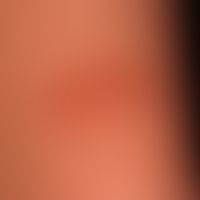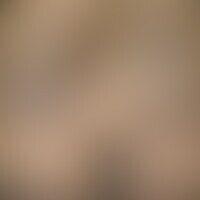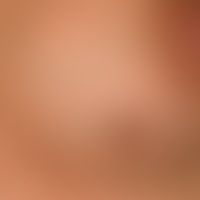Image diagnoses for "Torso", "Plaque (raised surface > 1cm)", "brown"
87 results with 240 images
Results forTorsoPlaque (raised surface > 1cm)brown
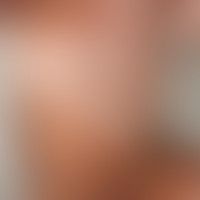
Nevus melanocytic congenital D22.-
Large congential melanocytic nevus (LCMN): no neurological sympotaxis detected (see below melanosis neurocutanea).
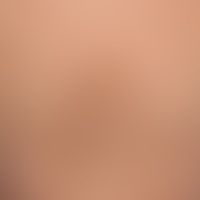
Confluent and reticulated papillomatosis L83.x
Papillomatosis confluens et reticularis: Patchy and flat, velvety yellow-brown plaques (harmless finding) in the sternoclavicular region and in the region of the upper abdomen.

Naevus melanocytic common D22.-
Nevus melanocytic more common: sharp border of the melanocytic nevus to the colored inked deposition border (here blue)

Becker's nevus D22.5
Becker-Naevus: During puberty and postpubertal increasing hairiness of a nevus previously only visible as a brown spot. No symptoms.

Darian sign
Urticaria pigmentosa of childhood: extensive redness and urticarial reaction in the lesions after mechanical irritation.

Maculopapular cutaneous mastocytosis Q82.2
Urticaria pigmentosa:multiple, chronically stationary, known for 1 year, no longer increasing for 3 months, mainly localised on the trunk, 0.2-0.4 cm in size, blurred, red to reddish-brownish, smooth spots. no spontaneous itching. after warm bathing, the spots are bright red, eleated and itchy (wheals). lively redness and wheals appear even after mechanical irritation.

Circumscribed scleroderma L94.0
scleroderma circumscribed (plaque-type). 46 years old patient. 10 years old clinical picture. extensive firmly indurated brown plaques on the trunk. "risen" pattern. smooth atrophic, mirror-like surface.
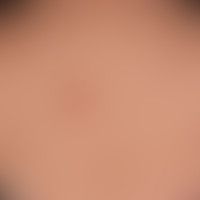
Sarcoidosis of the skin D86.3
Sarcoidosis plaque form: Symptomless, 5.0 cm large, coarse lamellar scaling plaque that has existed for several years.
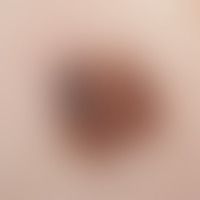
Keratosis seborrhoic (plaque type)
Keratosis seborrheic (plaque type): Flat irregularly bordered pigmented plaque.

Naevus melanocytic common D22.-
Nevus melanocytic more common: junctional and dermal melanocytic cell nests, superficially epitheloid and differently pigmented.
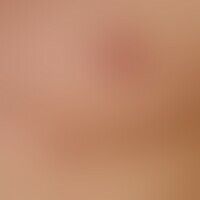
Nipple accessory Q83.3
Mammilla, accessory. 0.6 cm high, solitary, brown plaque, clearly grown during puberty, localized in the so-called embryonic lactiferous ridge, without symptoms, with a central pointed conical papule and a coarse-fielded surface.

Circumscribed scleroderma L94.0
scleroderma circumscripts (linear type): band-shaped expression of the scleroderma focus on the upper and lower leg. in the thigh area, clear atrophy of skin, subcutaneous fatty tissue (and muscles). clinical picture developed over a period of about 7 years. pulling and stabbing complaints during sports activities.

Naevus melanocytic common D22.-
Nevus melanocytic more common: dermal n evoid melanocytes with monomorphic nucleus and only a few single nucleoli in here neuroid cytomorphological features with a wider pale eosinophilic cytoplasmic border
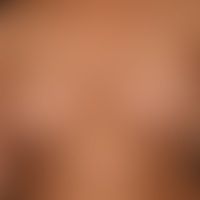
Poikiloderma (overview) L81.89
Poikiloderma: chronic graft versus host disease with bunchy, hyper- and depigmented indurated plaques.
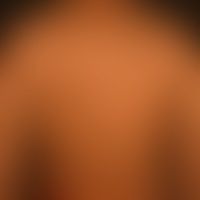
Nevus verrucosus Q82.5
Naevus verrucosus with bizarre arrangement of brownish papules and plaques along the Blaschko lines.
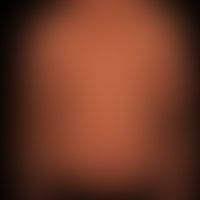
Kaposi's sarcoma (overview) C46.-
Kaposi's sarcoma:Generalization of angiosarcoma. Disseminated spots and flat plaques. Characteristic is the arrangement in the tension lines of the skin, whereby a striped arrangement is recognizable in places.

Keratosis seborrhoeic (overview) L82
keratosis seborrhoeic: multiple flat wart-like skin growths that have persisted for years. arrows mark smaller, flat, light brown seborrhoeic keratoses. encircled: verucosal plaques or nodules that have existed for a long time (several years). patient complains of itching at times.
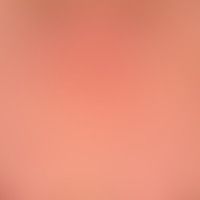
Sarcoidosis of the skin D86.3
Anular sarcoidosis: anular or circulatory chronic sarcoidosis of the skin. existing for several years. onset with small symptomless papules with continuous appositional growth and central healing. no detectable systemic involvement .

Circumscribed scleroderma L94.0
unilateral circumscribed scleroderma: unilateral "segmental" circumscribed scleroderma. the lightly pigmented large-area plaques have existed for about 5 years. no increasing "growth" in the last few months.
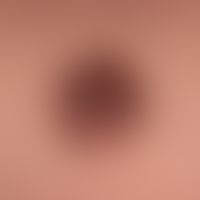
Melanoma superficial spreading C43.L
Melanoma superficially spreading: Plaque which is no longer symmetrical and smooth on the surface with several elongated growth zones which break through the contours of the edges, see further detailed images.
